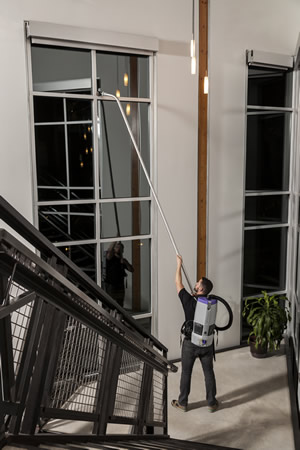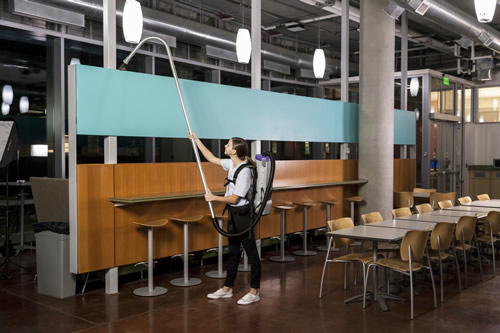ProTeam Cordless Backpack Vacuum Brings Speed and Safety to Stairwells
 The University of Washington is one of the world’s top institutions of higher education. The Building Services Department of the Seattle campus maintains 12 million square feet of facility space to a high standard of cleanliness and health. Of the 280 custodians in the building services department, 140 are involved in lean process improvement where groups of custodians work on shared problems.
The University of Washington is one of the world’s top institutions of higher education. The Building Services Department of the Seattle campus maintains 12 million square feet of facility space to a high standard of cleanliness and health. Of the 280 custodians in the building services department, 140 are involved in lean process improvement where groups of custodians work on shared problems.
Motivated by recent trips and slips on the stairs, building services created a lean process improvement group to tackle stairwell safety. Michael Nguyen, Training and Special Project Manager for Building Services, chaired the group as they brainstormed and tested various ideas. The group recommended moving to cordless backpack vacuums for stairwell cleaning. When they made the switch, they discovered that cordless cleaning did more than improve safety – it improved productivity as well.
The GoFree® Flex Pro cordless backpack vacuum from ProTeam® cleans 30 percent faster than a standard backpack vacuum and five times faster than an upright vacuum with an approximate 75-minute runtime. It eliminates time spent managing the cord and changing outlets, allowing the cleaner to take the most efficient path through a space. At the University, a stairwell of seven flights from basement to top floor took 30 minutes to clean with a corded backpack vacuum and only 10 minutes to clean with the GoFree Flex Pro.
“Everyone loves the cordless,” said Nguyen. “It cuts down the time spent versus the corded backpack vacuum. There is no cord to get stuck under furniture or partitions. It eliminates the tripping hazard for the custodian and for the student. We tried a variety of cordless backpack vacuums, and the ProTeam GoFree Flex Pro was much better.”

One of the lightest battery backpacks on the market, the GoFree Flex Pro cleans stairwells, high places, and around obstacles without tethering the cleaner to the nearest outlet. In high-traffic areas or 24-hour facilities, the GoFree Flex Pro can move among building occupants without presenting a tripping hazard. Running at only 63.7 decibels, it cleans without disturbing conversations nearby.
The GoFree Flex Pro includes an upgraded FlexFit® Articulating Harness. Thicker back and shoulder pads create more comfortable contact points, so cleaners can vacuum longer with greater comfort. Easy adjustments allow for an ergonomic fit on a wide range of body types.
Sponsored by ProTeam